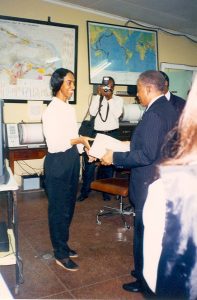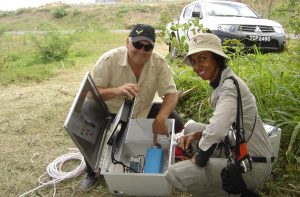15 July 2019 –Joan Latchman, a seismologist at The University of the West Indies Seismic Research Centre, was born in Trinidad and Tobago and grew up just a 15-minute walk from the Centre – then known as the Seismic Research Unit. At the time, the Centre had a low profile, but when she joined the Unit in 1972, she realized its value.
“We’re responsible for monitoring the earthquakes and volcanoes in the English-speaking Eastern Caribbean, from Trinidad in the south to St. Kitts in the north,” she says.
Like many seismologists, most of Latchman’s work revolves around seismic and volcanic data collected throughout the Eastern Caribbean.

President of the Republic of Trinidad and Tobago A.N.R. Robinson at the Seismic Research Centre, following the damaging 22 April 1997 earthquake. | SRC
“On a normal day, I’d come in and check with our technical staff who grab, read and process the data to make sure what we’re seeing is routine,” she says.
But when the data shows something that isn’t routine, Latchman and her colleagues have to determine whether it’s an indicator of something more significant to come.
Her interest in earthquake forecasting came during a 1982 earthquake sequence in Tobago. At the time, Latchman was a seismology technician working with Frank Dale Morgan, an MIT researcher who had just been assigned to the Seismic Research Centre.
Morgan and his colleagues applied what became known as a piecewise gradient technique to analyze a variant of the well-known Gutenberg-Richter law, which describes the relationship between the frequency of earthquakes in a particular region and their magnitude and shows that as magnitude increases, the number of earthquakes decreases.
Essentially, the technique puts each earthquake over a specific time period in a “magnitude bin” and plots the logarithm of those cumulative values, going from lower to higher magnitudes. In the long term, the line straightens.,
What Morgan noticed, however, was a departure from the straight line. Morgan, Latchman and their colleagues began trying to find where this new line was going to lead them by projecting which magnitude was necessary to re-fit a straight line – a bigger earthquake than any of the previous ones.
“As the sequence was developing, Morgan projected it would likely culminate in an earthquake greater than magnitude 5,” says Latchman. “The scientists alerted the authorities of our prognosis and three days later, a magnitude 5.2 earthquake occurred.”
After that initial success, Latchman began refining and expanding on Morgan’s piecewise gradient technique, applying it to look at earthquakes in 1997 near Tobago and to larger datasets such as those compiled by the National Earthquake Information Center. [Learn more about the difference between “prediction” and “forecasting when it comes to earthquakes.]
Latchman and her colleagues also have been investigating radon – a naturally occurring gas that comes from radium decay in rocks – as another potential earthquake forecasting tool. Scientists have theorized radon is released when rocks in faults are compressed prior to an earthquake.
Using tailored oil industry equipment, they’ve begun monitoring Trinidad and Tobago’s Water and Sewerage Authority’s observation wells for radon.
“In these observation wells, we can monitor radon fairly continuously,” says Latchman. “Every 10 minutes we can take a sample.”
However, the pilot project is currently stalled. Like most research facilities, funding is one of the central concerns at the Seismic Research Centre.
“We have always tried to be lean and efficient,” she says, “but even within the constraints of that leanness and efficiency, we’ve had our budget cut, so it has made it very challenging.”
Despite the setbacks, radon remains one of the areas Latchman is most interested in studying.

“We need an answer there,” she says. “If the pilot proves useful and we see precursory changes in the ambient radon, then we could have a radon network that would give another strand to our earthquake forecasting.”
Beyond forecasting, the seismically active nature of the region means outreach and education are other important parts of Latchman’s work.
“The reality of the seismic hazard to which our region is vulnerable is mostly lost on our people,” she says. “Of course, on 21 August, we had an M6.9 earthquake west of Trinidad, and that brought the reality home a little more forcefully.”
After the quake, Latchman and her colleagues held a press conference on Facebook to advise Trinidad and Tobago residents about the possibility of strong aftershocks.
Another one of her outreach efforts is the annual Earthquake and Tsunami SMART campaign in the territories within the Seismic Research Centre’s area of responsibility. “For those of us who live in earthquake country,” she says, “it’s very important to appreciate the hazards to which we’re vulnerable and have measures in place for when a major event occurs.”





修改评论